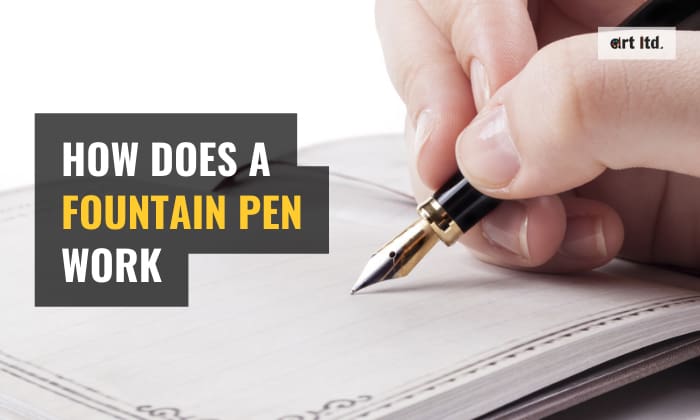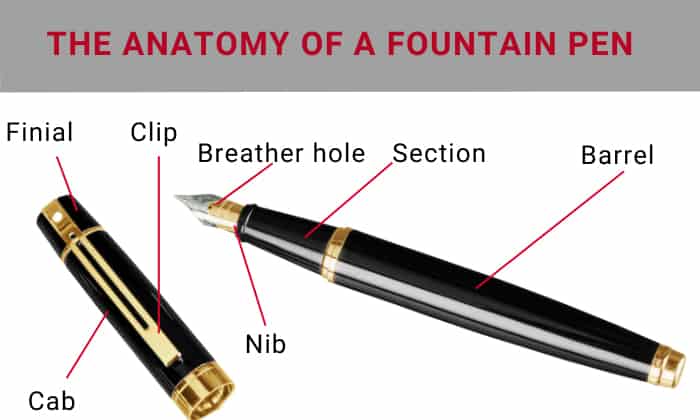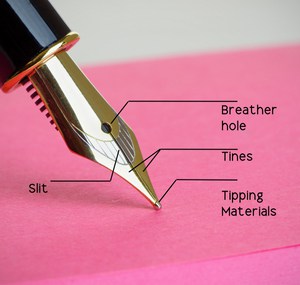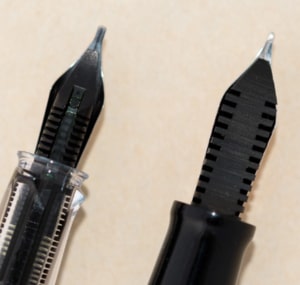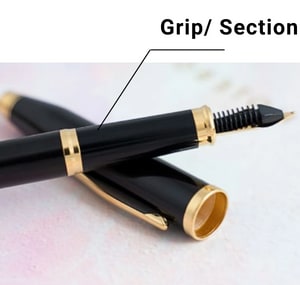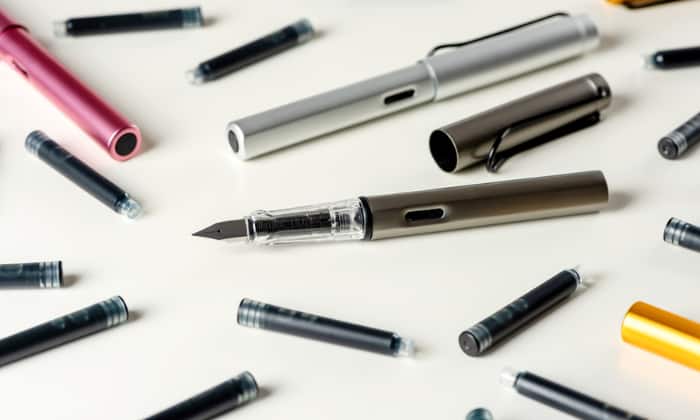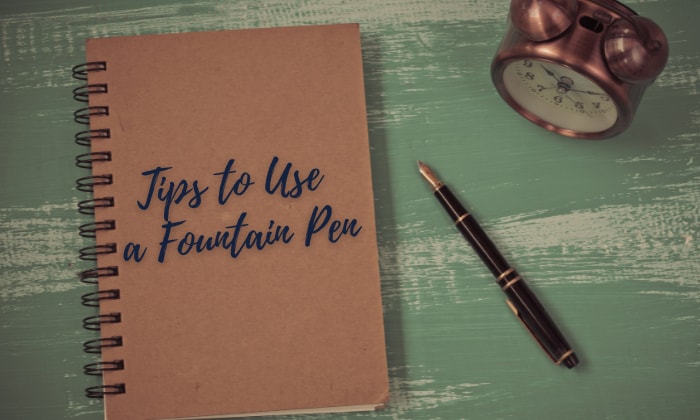Fountain pens have been around for several decades to replace inkwells and quills which created inconsistent and blotted lines. With a fountain pen, you can create constant, cursive, and beautiful writing without dipping the pen in ink many times.
Instead of paying a lot of money for single-use ballpoint pens, you can invest in a high-quality reservoir pen that is refillable to protect the environment.
Thanks to their advantages, many people use fountain pens, but do you understand how does a fountain pen work? The mechanism is based on capillary action and gravity.
Once you hold the pen and start to write across paper, gravity retracts ink from an ink holder inside the pen, then the ink appears at the nib due to capillary action for continuous writing. Let’s keep scrolling down to understand these operating principles.
Table of Contents
How Does a Fountain Pen Work?
A fountain pen holds a long story behind its compact and classic design. Many people believed that Leonardo da Vinci created fountain pens, since examination showed that his documents were written consistently.
Throughout many decades, fountain pens have improved and enabled users to suck ink through nibs with a lever or barrel, and store ink in reservoirs for next uses.
Fountain Pen Definition and Components
Design-wise, fountain pen basics include a tank for holding ink, a metal nib for writing, and others. If any pen lacks one or both core elements, it isn’t a fountain pen.
1. Cap
Almost all fountain pens are equipped with caps, while several pens use a retractable system to prevent the nibs from drying out. In case you forget to close the cap, don’t worry, you can dip the nibs into water or write several letters, then the pen can work normally.
2. Parts of a fountain pen nib
- Materials
The nib is a metal component directly touching the paper and is made from different materials: pure gold for antique items and gold alloys or stainless steel for a modern fountain pen. Their features are long-lasting, flexible, and corrosion-resistant.
To reinforce golden fountain pen tips, people usually wrap them with a solid metal called iridium or a metal alloy from platinum relatives.
- Tines
The nib is separated into 2 halves called the tines, which create a path for ink to flow from the ink cartridge to the tip.
- Nib’s flexibility
Different nibs’ flexibility and how much pressure you apply on them when writing create various thicknesses of lines. Vintage nibs are more adjustable, which is perfect for handwriting lovers. Semi-flexible nibs can create wide lines with harder force while modern pens are less adjustable due to the rigid nibs.
- Breather hole
The heart-shaped or circular hole on the nibs is called a breather hole. It can let air access the reservoir to release ink continuously and prevent vacuum forming. The hole also relieves the pressure on the nib to prevent it from being broken after multiple uses.
The ideal nibs’ design is that the slit between the tines should run from the breather hole to the tines, but the hole and the tines should be separate.
3. Feed
- Materials
The feed is made from plastic or ebonite and attached underneath the nib. Its shape is a long tube with 3 thin channels that pull the ink out of a cartridge and transfer it to the tip. The feed has a slit running from the back down to the front of the pen.
- Fins – What are pen fins for?
To provide you with more detail about how fountain pen feed work, let’s look at the fins – tiny and thin parts of the feed. Imagine if there are no fins, a large amount of ink will drop down; your pens will dry out so quickly once you hold the pen vertically.
A feed with fins can hold excess ink and manage to release it slowly and continuously. Besides, the pen fins purpose is to control the air to ensure it can return to the reservoir to prevent the ink from draining.
4. Grip or section
The grip is also known as the section that keeps the nib and the feed together and connects to the ink cartridge. Instead of separating the 3 pieces, several pens combine the nib and feed together in a nib collar. You can screw or unscrew the collar from the grip if you want.
5. Ink holder
The core part of a fountain pen making it different from a dipped pen is the ink reservoir, which can be a cartridge stored in a barrel with an eyedropper, or a converter. The holder is placed inside a protective accessory called a barrel, which helps you hold the pen firmly.
How Does It Work?
You can make a fountain pen work by letting air exchange happen inside the pen. When the air can come through the fins and the breather hole, the reservoir doesn’t form a vacuum anymore, making the ink flow constantly. The air will continue to flow back into the ink hole to maintain stable air pressure.
Gravity and capillary action are additional factors to get fountain pen to work. When you keep the pen vertically, ink molecules will be drawn from the reservoir to the feed then to the nib and their destination on the page, thanks to gravity, while capillary action adjusts the ink flow to prevent it from pouring out.
Ways the Ink Flow Through a Fountain Pen
The combination of gravity and capillary action helps you get ink flowing in fountain pen and produce consistent lines. Let’s look at the above diagram and the steps below to understand this process, or, how a fountain pen works animation.
1. Gravity draws ink from the reservoir
Gravity pulls 2 objects toward each other. Hence, when you place the nib on the paper upright, gravity draws ink from the cartridge toward the tip. Imagine that your pen only uses gravity to work, the ink will flow uncontrollably until there is no ink left in the reservoir. But don’t worry, capillary action was born to prevent that.
2. Capillary action application
Capillary action is the process of water or any liquid like ink flowing from large areas to narrow areas thanks to cohesion and adhesion forces against the effect of gravity.
Naturally, the fluid molecules stick together (cohesion) and adhere to the walls of the holder (adhesion). Once the adhesion force is stronger than the cohesion force, capillary action happens.
As mentioned, the feed is designed with fins, a middle slit, and a flat surface. The ink molecules stick to the fins; hence, they are areas to store excess ink and regulate ink on the nib to keep the ink from dripping out of pens. With gravity, the ink starts to flow out the tip and adhere to the page.
The Internal Filling Mechanism
- Cartridge
This is a disposal tube containing around 1 ml of ink. When you use up ink in a cartridge, you just need to replace it with new pigment. Although it is convenient to use, it limits you in choosing suitable inks for your pens.
- Piston
You can refill the piston fountain pen by opening the cap to use the little knob inside the pen, submerging the nip into the ink bottle, and screwing this knob to suck the ink into the chamber.
- Converter
This is an economical version of the first mechanism, the cartridge. Use the plunger to fill a fountain pen by drawing ink from the ink container. The converter also allows you to use cartridges if you want.
To make a fountain pen converter work, you just need to squeeze the sac to let the air out and release it to suck the ink.
Tips to Use a Fountain Pen
- When writing, you can post the cap on the end for a more balanced grip. Close the cap when not using the pen to avoid drying out ink and protect the nib from damage.
- If the dried ink blocks the flow, remove it or submerge the tip in water. Don’t forget to rinse the feed and nib before refilling the ink to eliminate unwanted residue.
- Place the tip of the index finger and middle finger on the nib, and put the pinkie finger on the barrel to hold the pen firmly. The right angle to place the nib on the paper is around 45-50 degrees vertically. Meanwhile, adjust your elbows on the table comfortably and apply gentle pressure when writing.
- Choose compatible paper to use with ink if you don’t want to leave a mess on it (around 60 to 90 gsm).
- If you use fountain pens continuously, you can place them on a flat surface. Otherwise, store them with the nib upward to protect the nib.
- You can utilize cursive lines to reduce the time in lifting and putting down a pen.
Frequently Asked Questions
Different types of fountain pen nibs?
Based on your preferences, you can select 3 types of fountain pen nibs.
- Broad nibs aka chisel-edged or board-edge nibs are the least flexible. The lines they create are thick vertically and thin horizontally.
- Calligraphy/italic/stud nibs come in 0.9 – 1.5mm in sizes. You can write smaller lines than with broad nibs, but the vertical lines are still pretty thick in cursive letters.
- Pointed nibs can produce the same lines in all directions and angles. These are not the best for writing thick lines, but they are flexible if you know how to adjust the pressure on the pen tip.
What is special about fountain pens?
Fountain pens allow you to create handwriting masterpieces while stamping your style on them. You can pick any ink color you love and transfer it to paper. Besides, you can create numerous writing styles by changing nib sizes and shapes and modifying the angle, pressure, and direction while using the pens.
How long do fountain pens last?
Depending on the materials, the shelf life of fountain pens can be varied, with plastic and rubber having a longer lifespan. To be specific, a good fountain pen can last for 10-20 years if you take care of them properly, and even longer for premium-quality pens.
Conclusion
Fountain pens can be different in designs and patterns, but how does a fountain pen work is the same with similar key components. Using these pens allows you to promote creativity and lend a personal touch to journals, letters, and other forms of writing.
If you use this pen for the first time, you can find controlling it is quite hard; however, you just need to practice regularly to create excellently cursive lines. Don’t be shy to reach out to us if you have any questions about Montblanc fountain pen and others. We are always willing to give you short and correct answers.

Art has always been a part of my life; it influences my upbringing and later my career choice. For me, it is always a part of my parenting technique. So for whichever purpose that you come to art, you can start here with us.
